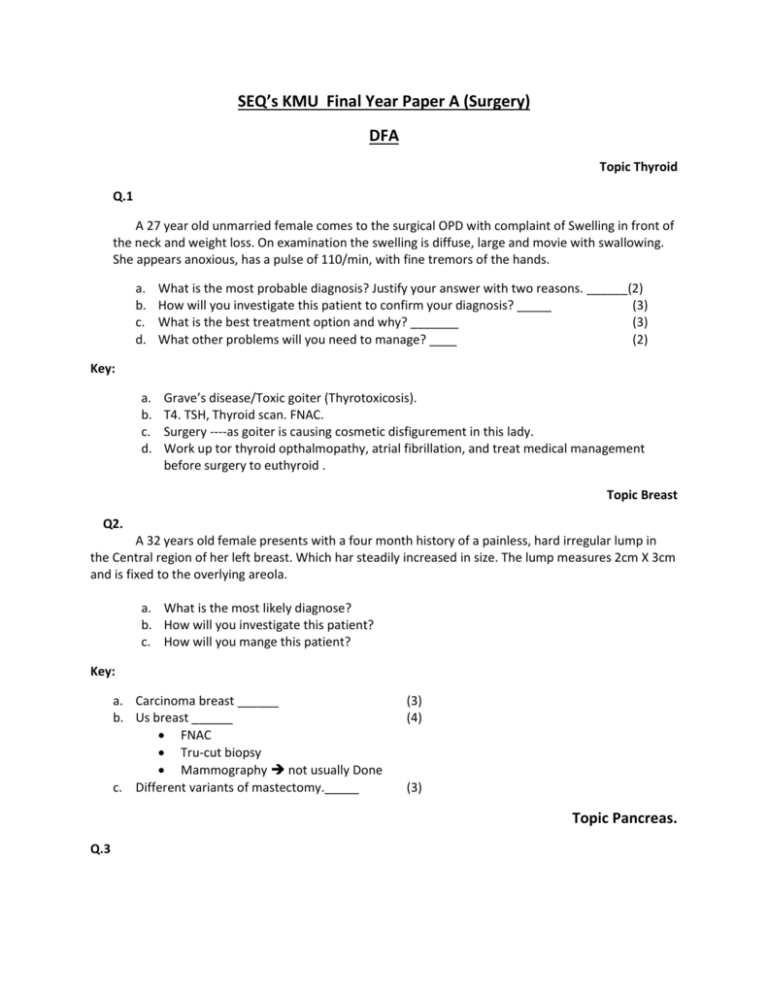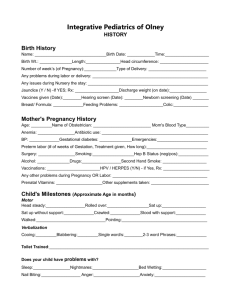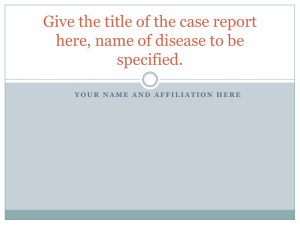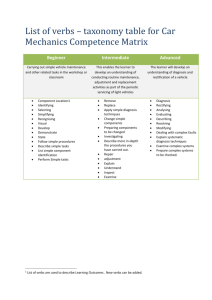SEQ`s SURGERY
advertisement

SEQ’s KMU Final Year Paper A (Surgery) DFA Topic Thyroid Q.1 A 27 year old unmarried female comes to the surgical OPD with complaint of Swelling in front of the neck and weight loss. On examination the swelling is diffuse, large and movie with swallowing. She appears anoxious, has a pulse of 110/min, with fine tremors of the hands. a. b. c. d. What is the most probable diagnosis? Justify your answer with two reasons. ______(2) How will you investigate this patient to confirm your diagnosis? _____ (3) What is the best treatment option and why? _______ (3) What other problems will you need to manage? ____ (2) Key: a. b. c. d. Grave’s disease/Toxic goiter (Thyrotoxicosis). T4. TSH, Thyroid scan. FNAC. Surgery ----as goiter is causing cosmetic disfigurement in this lady. Work up tor thyroid opthalmopathy, atrial fibrillation, and treat medical management before surgery to euthyroid . Topic Breast Q2. A 32 years old female presents with a four month history of a painless, hard irregular lump in the Central region of her left breast. Which har steadily increased in size. The lump measures 2cm X 3cm and is fixed to the overlying areola. a. What is the most likely diagnose? b. How will you investigate this patient? c. How will you mange this patient? Key: a. Carcinoma breast ______ b. Us breast ______ FNAC Tru-cut biopsy Mammography not usually Done c. Different variants of mastectomy._____ (3) (4) (3) Topic Pancreas. Q.3 A 45 years old female patient presents in emergency e a 2 days history of severe upper Abdominal pain radiating to the Back and vomiting. On the examination her pulse is 100/min, BP.90/70. She is tender in the epigastrium. There is some Blush discoloration around the umbilicus. a. What is the most probable diagnosis? b. Name the Grading system to assess the severity of condition. c. Outline the medical and surgical Tx options? Key: a. Acute Pancreatitis ____ b. Ranson’s score and Clasgow scale _______ c. Medical .NBM, ivjenid, ivantibiotics,analgesics, PPIs. Surgical, Drainage necrosectomy (1). (1). (3) Topic Kidney Q. 4 A 16 years old girl presents to the emergency room with four day history of pain in her right lumber area. This pain is colicky and is associated and Nausea. she underwent left dyelo-lithotomy 2 years ago. a. What is your diagnosis? b. What investigations for doing investigation? c. How will you treat this patient? Key: a. Recurrent Renal stones _____(3) b. Fola confirmation of stone x-ray KUB, urine R/E, us abd and plexus IVU ____(4) To find out underlying cause s.calcium. alkaline phosphatuse, secum PTH, PTH scan, s.uric acid, urinary calcium. C. I. II. III. IV. Laparoscopice Px PCN ESWL URS+ICL Topic Appendix Q5. A 19 years old married female presents to surgical OPD which pain in the Right ilice fussa of 14 hours duration. And vomiting and fever. Her tempix 100 f and pulse rate is 90/min. Her face is flushed and TLC=16000/cm. a. What is your probable DX. b. What are D/D in this particular cases? c. How will you prepare for surgery? Ans. a. Acute appendicitis. ______(3) b. Ectopic pregnancy. Complicated ovarian apt, PID, acute cholecystitis, ureteric colic. ______(4) c. informed consent, NBM for at least 4-6hours, preoperative antibodies, baseline investigations, __(4) Topic Liver Q6. A 30 years old physically fit farmer presents a huge mass in the right hypochondrium U/S shows a large cyst of 10cm x 10cm in the right tube of the liver. a) b) c) d) What is the Diagnose? What investigations will oprcfocim? What complication can occur if left on treated. How will u treat this patient and what intra_operative precaution should be taken? Key: a. Hydatiadcyst of liver. ______(3) b. FBC, x-ray abdomen and chest,CT/MRI, Casoni’s reaction, U/S guided percutaneous aspiration, complement fixation test. c. Laparoscopic management _____(4) Open cyst excision. Pair and pair PD Topic Gall Bladder Q.7. A 50 years old lady had undergone laparoscopic cholecystectomy 15 days back. She presents with jaundice. a. Enumerate the possible causes of jaundice in this lady. b. Name the relevant investigations required in this lady. c. What is the management? Key: a. Clipped / Ligated CBD instead of cystic Duck, stone in CBD, Biliary structures____(3) b. U/S abdomen, ERCP/MRCP, T-tube cholangiography. ____(4) Topic Skin Q8. A 40 years old lady presents with a 1.5cm non- healing ulcer, with rolled edges on the right cheek? a. b. c. d. What is your diagnosis? What are differential diagnosis? How will you confirm the diagnosis? What are treatment options with merits and demerits? Ans: a. Basal cell carcinoma and rodent ulcer ____(3) b. D/D squamous cell carcinoma Malignant melanoma Keratocanthoma. ____(4) c. Wedge biopsy Excisional biopsy. ______(3) Topic Skin Q.9 A 10 years old girl has got painless swelling on the face at the left outer angle of the eye since Birth. It is gradually increasing in size. a. b. c. d. What is the most likely diagnosis? What is etiology? What is differential diagnosis? Any special investigations you would like to do? Key: a. Decnoid cyst ____(3) b. Hemangioma, cystic Hygroma. Sebaceous cyst, lipoma. ____(4) c. CT/MRI for intracranial extension. _____(3) Topic Hernias Q10. A 50 years old man presents with one day history of abdominal pain and vomiting. On examination he is tachycardia and the abdomen is distended and tender. He also has a huge, firm tender swelling in his right groin. a. What is your diagnosis? b. What investigations will u Diagnosis? c. What is the management? Ans: a. Strangulated inguinal hernia ___(3) b. U/S abdomen and pelvis, ECG, X-ray chest other pre-op routine investigations ___(3) c. Informed consent+ preparation for surgery, surgical repair, postoperative case ____(4) Area Topic Large Bowel Q11. A 60 years old man is referred for evaluation because of having fainted at his job where he operates heavy machinery. There is a history of weight loss and attired Bowel habits. He is pale but otherwise his physical examination is unremarleable. He has 4, occult blood in the stoop and lab reports and how an his of 5g. a) What is the most probable? Write 2 points of fortification? b) How will you confirm your diagnosis? c) How will you manage this patient? Ans. a. Colorectal carcinoma ___(2) b. Procto-sigmoidoscopy with Biopsy Barium Enema, CT/MRI, Endo-luminal U/S___(3) c. Informal consent Preparatim for surgery Appropriate coleitorny and repair Postoparature Management. Topic kidney Q12. A three years old child presents with Haematuria. Clinical examination reveals a flank mass. a. What is your diagnosis? b. What are differential diagnoses? c. What is the treatment of the most likely diagnosis? Ans: a. Wilm’s tumor _____(3) b. Congenital renal cyst Neuroblastoma. Perinephric abscess.____(3) c. Radical mephrectomy @ adjuvant radio and chemotherapy ____(4) Topic Biliary Tract Q13. A 55 years old female patient had chronic cholecystitic associated with multiple small gallstones. She was advised cholecystectomy but absconded and went to homeopath for treatment. After two years she presents with obstructive jaundice and fever. a. What complication has occurred? b. How will you investigate? c. What are different treatment options? Ans; a. Cholangitis secondary to stone in CBD ____(3) b. U/S abdomen, CT/MRI, ERCP/MRCP FBC, LFT, ALT, Alkaline phosphates._____(3) c. A) laprascopic cholecyste ctomy and CBD exploration Open chole+CDB exploration ERCP+cholecystectony Topic Stomach and Duodenum Q14. A young man of 40years presented with sudden ohset of pain in the epigastric region spreading to whole abdomen. He has history of taking Drugs for joint pain. a. What is the most probable diagnosis? b. List the investigations to confirm your diagnosis? c. Outline the management plans? Ans: a. Perforated peptic ulcer____(3) b. X-ray abdomenerect/x-ray chest s.amylase U/S abdomen . ____(3) c. Informed consent Preparation for surgery Exploration laparolony and repair Postoperatine care. Topic Esophagus Q15. A 40years old man presented with Dysphagia which was for solids only to start with and then became complete both for solids and liquids? a. What is likely cause of DYSPHAGIA in this patient? b. Name the differential diagnosis? c. How will you manage this case? Ans: a. Carcinoma Esophagus. _____(3) b. Post-cricoid carcinoma ______(3) Esophageal webs. Esophageal strictures. Achalaria Zenker’s Diverticulum Mediastinal mass c. Preparation for surgery/optimization ____(4) Informed consent Surgery (Esophagectomy) Postoperative management








